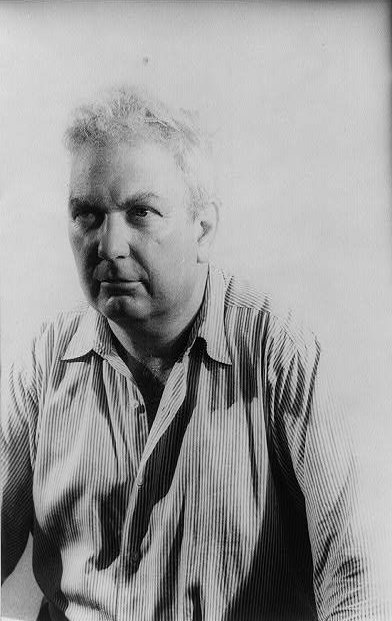Origine: Citato in G. Baldi, S. Giusso, M. Razetti e G. Zaccaria, Dal testo alla storia dalla storia al testo , [Letteratura italiana con pagine di scrittori stranieri, Analisi dei testi e critica, vol III, tomo secondo, Dal Decadentismo ai giorni nostri, Storia del teatro e dello spettacolo a cura di Gigi Livio], Paravia, Torino, 1993. ISBN 88 395 0453 2
Alexander Calder Frasi e Citazioni
Alexander Calder: Frasi in inglese
1920s, Statement on Wire Sculpture' (1929)
“Fernand Léger's film, 'Ballet Mecanique' is the result of the desire for a picture in motion.”
1930s - 1950s, Statement from Modern Painting and Sculpture', (1933)
Question, Léger once called you a realist. How do you feel about this?
1950s - 1960s, interview with Alexander Calder', (1962)
1930s - 1950s, Statement from Modern Painting and Sculpture', (1933)
“Therefore, why not plastic forms in motion?... one can compose motions.”
1930s - 1950s, Statement from Modern Painting and Sculpture', (1933)
Question, Is it true that Marcel Duchamp invented the name “mobile” for your work?
1950s - 1960s, interview with Alexander Calder', (1962)
“.. the elimination of other things which are not essential will make for a stronger result.”
1930s - 1950s, Statement from Modern Painting and Sculpture', (1933)
Quote (1951), in 'What Abstract Art Means to Me' http://www.jstor.org/stable/4058250, George L. K. Morris, Willem De Kooning, Alexander Calder, Fritz Glarner, Robert Motherwell, Stuart Davis; as cited in the The Bulletin of the Museum of Modern Art, Vol. 18, No. 3, (Spring, 1951), pp. 2-15
1950s - 1960s
Calder, quoted in Calder: Gravity and Grace, eds. Giménez, Carmen, and Alexander S.C. Rower; Phaidon Press, New York 2004, p. 54
1950s - 1960s
Question, Which has influenced you more, nature or modern machinery?
1950s - 1960s, interview with Alexander Calder', (1962)
1920s, Statement on Wire Sculpture' (1929)
Quote in his autobiography (1922); as cited in 'Calder' 1966, pp. 54–55; as quoted on Wikipedia: Alexander Calder
In June 1922, Calder found work as a mechanic on the passenger ship H. F. Alexander. Calder slept on deck and awoke one early morning off the Guatemalan Coast; he saw both the sun rising and the full moon setting on opposite horizons
1920s
Quote of Calder (8 March 1932), in text 'That which moves - On mobile sculptures', unpubl. MS https://web.archive.org/web/20110222045901/http://calder.org:80/historicaltexts/text/5.html, 1932, Calder Foundation Archives, New York
1930s - 1950s
Quote (1930), from a studio-visit at Mondrian's place in Paris, as cited by by Mondrian's recent biographer Hans Janssen, of the Gemeentemuseum in The Hague; as cited by Alastair Sooke, in 'Mondrian - the Joy of Being Square'; BBC culture, 10 July 2017 http://www.bbc.com/culture/story/20170710-mondrian-the-joy-of-being-square
1930s - 1950s
Question, How do you get that subtle balance in your work?
1950s - 1960s, interview with Alexander Calder', (1962)
1930s - 1950s, Statement from Modern Painting and Sculpture', (1933)
Quote of Calder (1943) in his essay A Propos of Measuring a Mobile, Calder Foundation; as quoted in Calder and Mondrian: An Unlikely Kinship, senior-thesis by Eva Yonas http://citeseerx.ist.psu.edu/viewdoc/download?doi=10.1.1.517.581&rep=rep1&type=pdf, Ohio State University August 2006, Department of Art History, p. 19
1930s - 1950s
1920s, Statement on Wire Sculpture' (1929)
In Montparnasse, I became known as the 'King of Wire'.
Quote of Alexander Calder (1952), looking back, from Permanence Du Cirque, in 'Revue Neuf', Calder Foundation, 1952; as quoted in Calder and Mondrian: An Unlikely Kinship, senior-thesis by Eva Yonas http://citeseerx.ist.psu.edu/viewdoc/download?doi=10.1.1.517.581&rep=rep1&type=pdf, Ohio State University August 2006, Department of Art History, p.19 – note 26
Calder first began using wire extensively in 1926, creating mechanical toys that would be the precursors to the Paris' 'Cirque Calder'
1950s - 1960s
1930s - 1950s, Statement from Modern Painting and Sculpture', (1933)
Origine: en.wikiquote.org - Alexander Calder / Quotes of Alexander Calder / 1930s - 1950s / Statement from Modern Painting and Sculpture', (1933)
“Question, What artists do you most admire?”
1950s - 1960s, interview with Alexander Calder', (1962)
“Goya, Miró, Matisse, Bosch and Klee.”
Question, What artists do you most admire?
1950s - 1960s, interview with Alexander Calder', (1962)
1950s - 1960s, Excerpt, What Abstract Art Means to Me (1951)
1950s - 1960s, Excerpt, What Abstract Art Means to Me (1951)
1950s - 1960s, Excerpt, What Abstract Art Means to Me (1951)
1940s, Excerpt, A Propos of Measuring a Mobile (1943)
1940s, Excerpt, A Propos of Measuring a Mobile (1943)
1940s, Excerpt, A Propos of Measuring a Mobile (1943)
En.wikiquote.org - Alexander Calder / Quotes / 1930s / Statement from Modern Painting and Sculpture (1933)
1930s, Statement from Modern Painting and Sculpture (1933)
